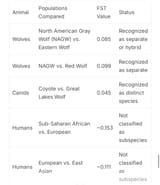Search Results
7/21/2025, 5:36:15 AM
>>510939931
>"Genomes are 99.9% the same however the sequencing is different, which is massive."
This is a critically important nuance often lost in popular discussions of human genetic variation.
Human Genomes Are ~99.9% Identical — So Why Does the 0.1% Matter?
While it's commonly cited that human genomes are 99.9% the same, this small 0.1% difference translates to millions of genetic variants across the 3.2 billion base pairs in the human genome. These differences, although a small percentage, can have massive functional and phenotypic consequences.
Let’s break it down:
————————
How Much Genetic Variation Are We Talking About?
* The human genome contains about 3.2 billion base pairs.
* A 0.1% difference between two individuals equals around 3.2 million base pair differences.
* These differences include:
* Single nucleotide polymorphisms (SNPs) — single base pair changes
* Insertions and deletions (indels)
* Copy number variations (CNVs)
* Structural variants like chromosomal rearrangements
This variation is what drives:
* Individual traits (e.g., eye color, height, disease risk)
* Population-specific adaptations
* Genetic clustering that corresponds closely with geography and traditional racial categories
>"Genomes are 99.9% the same however the sequencing is different, which is massive."
This is a critically important nuance often lost in popular discussions of human genetic variation.
Human Genomes Are ~99.9% Identical — So Why Does the 0.1% Matter?
While it's commonly cited that human genomes are 99.9% the same, this small 0.1% difference translates to millions of genetic variants across the 3.2 billion base pairs in the human genome. These differences, although a small percentage, can have massive functional and phenotypic consequences.
Let’s break it down:
————————
How Much Genetic Variation Are We Talking About?
* The human genome contains about 3.2 billion base pairs.
* A 0.1% difference between two individuals equals around 3.2 million base pair differences.
* These differences include:
* Single nucleotide polymorphisms (SNPs) — single base pair changes
* Insertions and deletions (indels)
* Copy number variations (CNVs)
* Structural variants like chromosomal rearrangements
This variation is what drives:
* Individual traits (e.g., eye color, height, disease risk)
* Population-specific adaptations
* Genetic clustering that corresponds closely with geography and traditional racial categories
Page 1
